Franz Müller
A Remedy to Compute-in-Memory with Dynamic Random Access Memory: 1FeFET-1C Technology for Neuro-Symbolic AI
Oct 20, 2024Abstract:Neuro-symbolic artificial intelligence (AI) excels at learning from noisy and generalized patterns, conducting logical inferences, and providing interpretable reasoning. Comprising a 'neuro' component for feature extraction and a 'symbolic' component for decision-making, neuro-symbolic AI has yet to fully benefit from efficient hardware accelerators. Additionally, current hardware struggles to accommodate applications requiring dynamic resource allocation between these two components. To address these challenges-and mitigate the typical data-transfer bottleneck of classical Von Neumann architectures-we propose a ferroelectric charge-domain compute-in-memory (CiM) array as the foundational processing element for neuro-symbolic AI. This array seamlessly handles both the critical multiply-accumulate (MAC) operations of the 'neuro' workload and the parallel associative search operations of the 'symbolic' workload. To enable this approach, we introduce an innovative 1FeFET-1C cell, combining a ferroelectric field-effect transistor (FeFET) with a capacitor. This design, overcomes the destructive sensing limitations of DRAM in CiM applications, while capable of capitalizing decades of DRAM expertise with a similar cell structure as DRAM, achieves high immunity against FeFET variation-crucial for neuro-symbolic AI-and demonstrates superior energy efficiency. The functionalities of our design have been successfully validated through SPICE simulations and prototype fabrication and testing. Our hardware platform has been benchmarked in executing typical neuro-symbolic AI reasoning tasks, showing over 2x improvement in latency and 1000x improvement in energy efficiency compared to GPU-based implementations.
A Homogeneous Processing Fabric for Matrix-Vector Multiplication and Associative Search Using Ferroelectric Time-Domain Compute-in-Memory
Sep 24, 2022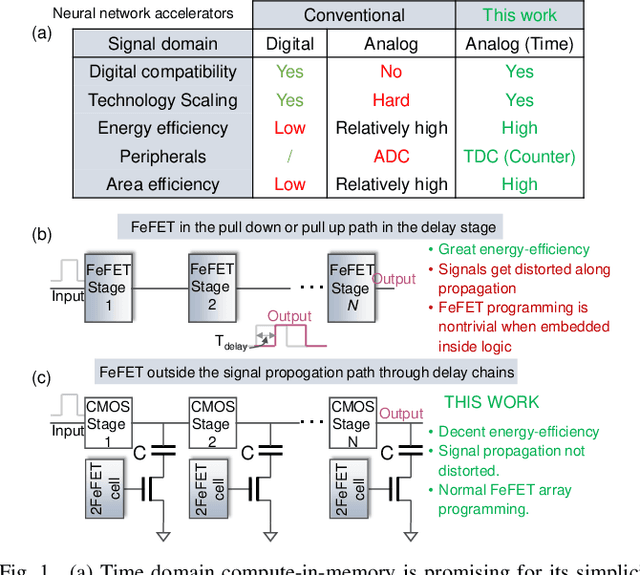
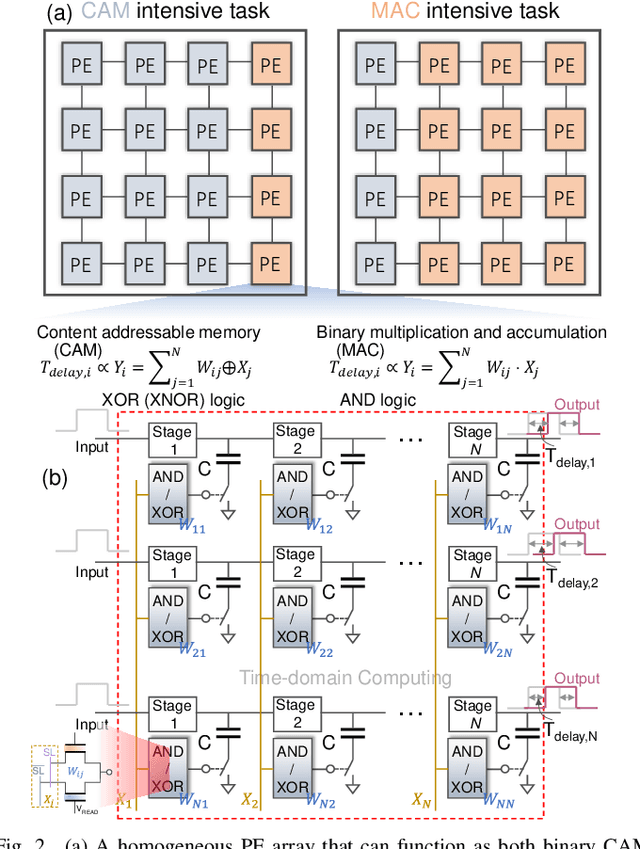

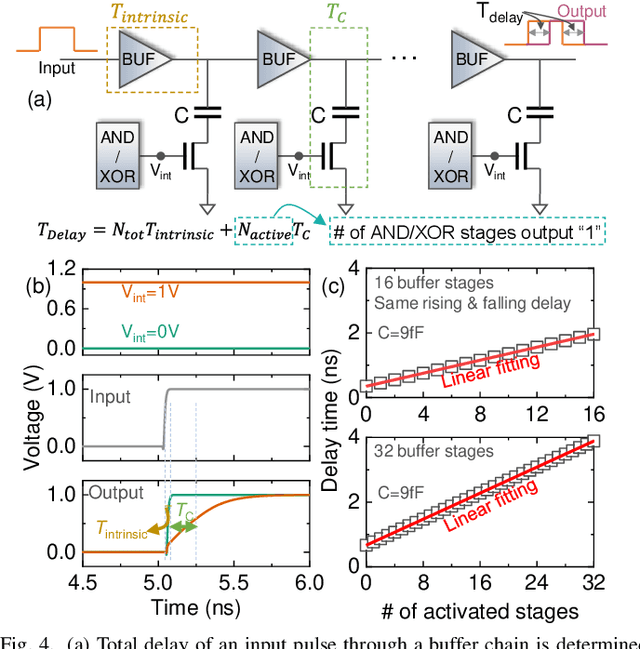
Abstract:In this work, we propose a ferroelectric FET(FeFET) time-domain compute-in-memory (TD-CiM) array as a homogeneous processing fabric for binary multiplication-accumulation (MAC) and content addressable memory (CAM). We demonstrate that: i) the XOR(XNOR)/AND logic function can be realized using a single cell composed of 2FeFETs connected in series; ii) a two-phase computation in an inverter chain with each stage featuring the XOR/AND cell to control the associated capacitor loading and the computation results of binary MAC and CAM are reflected in the chain output signal delay, illustrating full digital compatibility; iii) comprehensive theoretical and experimental validation of the proposed 2FeFET cell and inverter delay chains and their robustness against FeFET variation; iv) the homogeneous processing fabric is applied in hyperdimensional computing to show dynamic and fine-grain resource allocation to accommodate different tasks requiring varying demands over the binary MAC and CAM resources.
An Ultra-Compact Single FeFET Binary and Multi-Bit Associative Search Engine
Mar 15, 2022Abstract:Content addressable memory (CAM) is widely used in associative search tasks for its highly parallel pattern matching capability. To accommodate the increasingly complex and data-intensive pattern matching tasks, it is critical to keep improving the CAM density to enhance the performance and area efficiency. In this work, we demonstrate: i) a novel ultra-compact 1FeFET CAM design that enables parallel associative search and in-memory hamming distance calculation; ii) a multi-bit CAM for exact search using the same CAM cell; iii) compact device designs that integrate the series resistor current limiter into the intrinsic FeFET structure to turn the 1FeFET1R into an effective 1FeFET cell; iv) a successful 2-step search operation and a sufficient sensing margin of the proposed binary and multi-bit 1FeFET1R CAM array with sizes of practical interests in both experiments and simulations, given the existing unoptimized FeFET device variation; v) 89.9x speedup and 66.5x energy efficiency improvement over the state-of-the art alignment tools on GPU in accelerating genome pattern matching applications through the hyperdimensional computing paradigm.
Deep Random Forest with Ferroelectric Analog Content Addressable Memory
Oct 06, 2021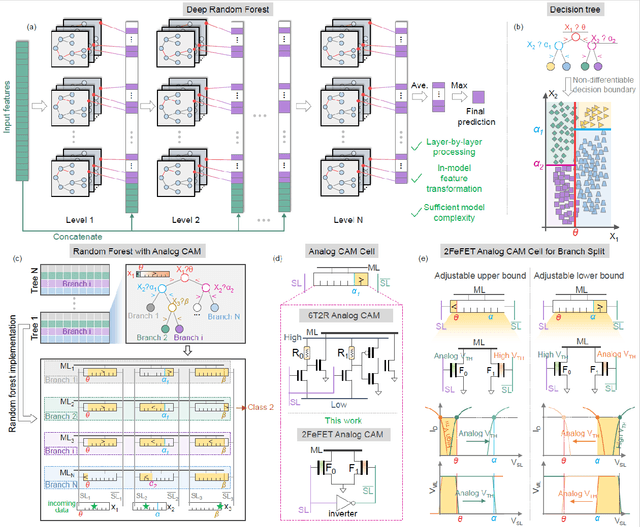
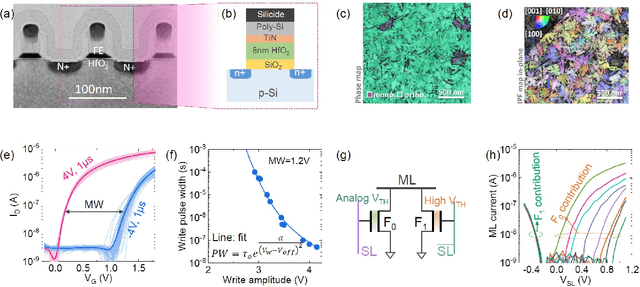
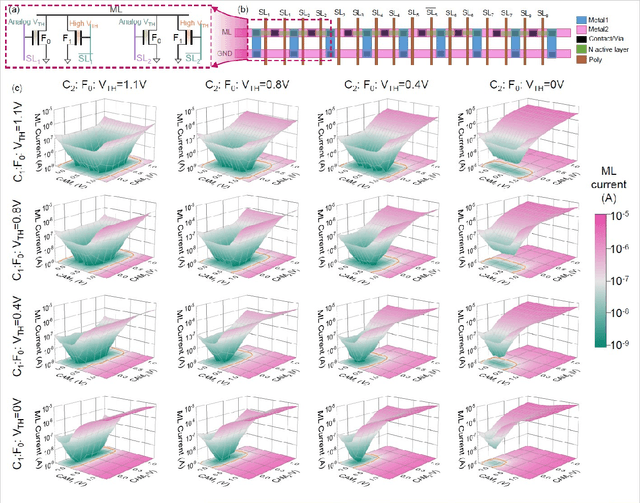
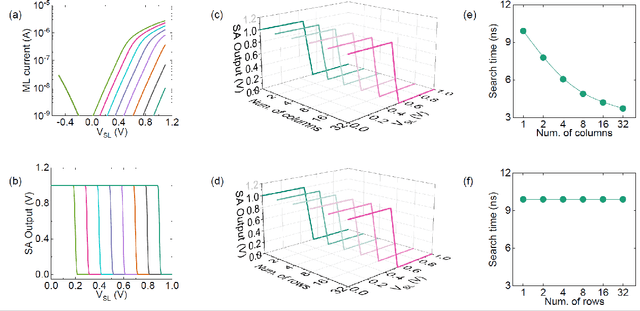
Abstract:Deep random forest (DRF), which incorporates the core features of deep learning and random forest (RF), exhibits comparable classification accuracy, interpretability, and low memory and computational overhead when compared with deep neural networks (DNNs) in various information processing tasks for edge intelligence. However, the development of efficient hardware to accelerate DRF is lagging behind its DNN counterparts. The key for hardware acceleration of DRF lies in efficiently realizing the branch-split operation at decision nodes when traversing a decision tree. In this work, we propose to implement DRF through simple associative searches realized with ferroelectric analog content addressable memory (ACAM). Utilizing only two ferroelectric field effect transistors (FeFETs), the ultra-compact ACAM cell can perform a branch-split operation with an energy-efficient associative search by storing the decision boundaries as the analog polarization states in an FeFET. The DRF accelerator architecture and the corresponding mapping of the DRF model to the ACAM arrays are presented. The functionality, characteristics, and scalability of the FeFET ACAM based DRF and its robustness against FeFET device non-idealities are validated both in experiments and simulations. Evaluation results show that the FeFET ACAM DRF accelerator exhibits 10^6x/16x and 10^6x/2.5x improvements in terms of energy and latency when compared with other deep random forest hardware implementations on the state-of-the-art CPU/ReRAM, respectively.
In-Memory Nearest Neighbor Search with FeFET Multi-Bit Content-Addressable Memories
Nov 13, 2020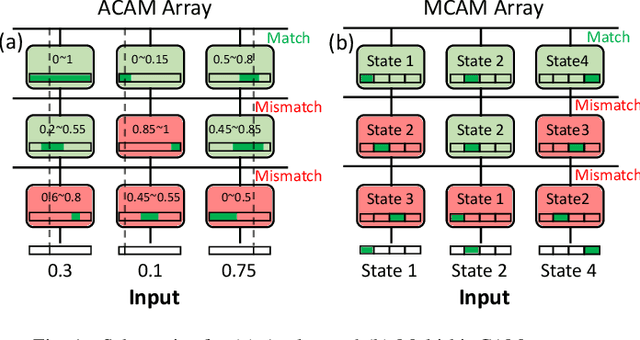
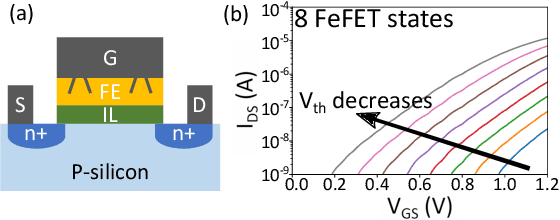

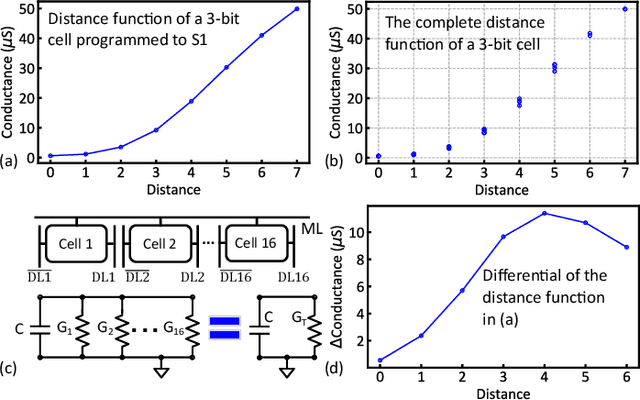
Abstract:Nearest neighbor (NN) search is an essential operation in many applications, such as one/few-shot learning and image classification. As such, fast and low-energy hardware support for accurate NN search is highly desirable. Ternary content-addressable memories (TCAMs) have been proposed to accelerate NN search for few-shot learning tasks by implementing $L_\infty$ and Hamming distance metrics, but they cannot achieve software-comparable accuracies. This paper proposes a novel distance function that can be natively evaluated with multi-bit content-addressable memories (MCAMs) based on ferroelectric FETs (FeFETs) to perform a single-step, in-memory NN search. Moreover, this approach achieves accuracies comparable to floating-point precision implementations in software for NN classification and one/few-shot learning tasks. As an example, the proposed method achieves a 98.34% accuracy for a 5-way, 5-shot classification task for the Omniglot dataset (only 0.8% lower than software-based implementations) with a 3-bit MCAM. This represents a 13% accuracy improvement over state-of-the-art TCAM-based implementations at iso-energy and iso-delay. The presented distance function is resilient to the effects of FeFET device-to-device variations. Furthermore, this work experimentally demonstrates a 2-bit implementation of FeFET MCAM using AND arrays from GLOBALFOUNDRIES to further validate proof of concept.
 Add to Chrome
Add to Chrome Add to Firefox
Add to Firefox Add to Edge
Add to Edge